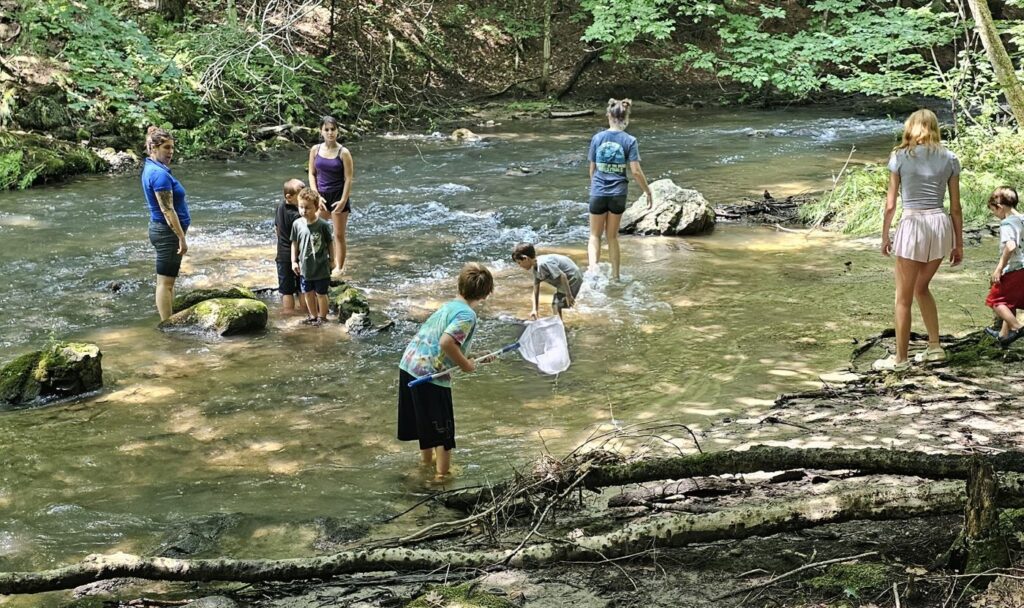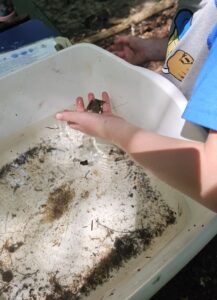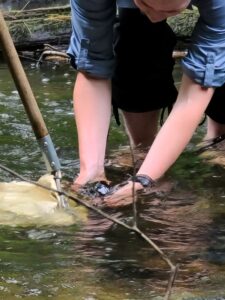
(This is the third guest blog post in our occasional series, Stream Explorers and Youth)
This summer at the YMCA of Auburn-Lewiston’s Outdoor Learning and Education Center (OLEC) we had the opportunity to run a Stream Explorers activity as part of our regular summer camp programming. The center is a 97-acre property located in Auburn just a short distance from the business center of the community.
Bobbin Mill Brook is a small body of water that runs from the outlet of Lake Auburn, through our site, and into the Androscoggin River. There are several great zones for study, and we have set up classrooms at multiple spots to run brookside learning activities. One lab site has a half-mile wheelchair accessible trail leading to it that creates a unique opportunity for young researchers using mobility devices to participate in the activities as well.

We introduced the program to youth from kindergarten age through high school, as well as to a few adults who were curious to learn. This year we were fortunate to partner with the Androscoggin Valley Soil and Water Conservation District and had Outdoor Educator and all-around nature enthusiast Emma Larusso join us for our learning adventures.
For camp activities the youth are in groups based on grade level and participate with their peers. Our middle school aged groups split up into research teams of four. We had two specimen collectors go into the brook to gather samples and two data collectors to receive and document the findings. Roles were flexible and all students had the opportunity to participate in either role. Our counselor-in-training campers lent a hand in demonstrations and instruction on good collection technique and had the opportunity to use GoPro cameras to capture some great underwater footage of the sample collection process.
Once the samples were secured the data collection began. We had such an incredible variety of organisms and most of the researchers were blown away by the richness of even our humble little waterways. Each of our groups made some great discoveries and with such a nice variety they were able to rotate around other stations to compare samples.
We had incredible cased caddis, hellgrammites, mayflies, dragonflies, as well as frogs, crayfish, and minnows. Students were able to sort through the samples and compare what they saw with laminated field guides. From there they could check off different species and take measurements and observations. Emma and I were able to go around to each station and discuss the various species and their roles in the ecosystem.
Many of the kids were laughing and swearing off ever going in the water again based on the number of critters that lived in it. After a short time, though, they realized the important role they all played in the water and became comfortable with “coexisting” in the brook.
Once the older groups were done, it was time for our youngest campers to come down to the water and have a turn. We had a staff member with each group play the part of the sample collectors. With the amount of rainwater we had this summer, the brook was still moving a little quickly for our small fry so we gave an assist for safety. The children were able to watch as we collected our samples and discussed the process. Once we were on dry land, they took over the next step of the process, handling the nets and buckets. Screeches of surprise and excitement filled the woods as the youth saw the collection tubs get filled and watched as things wiggled, darted, and crawled around in the water. Some of the kids got to touch a frog for the first time. They commented on how smooth they felt and what great swimmers they were. A crayfish molting cast-off gave some kids an opportunity to hold and have a safe and up-close look at the exoskeleton of these typically skittish and pinch-hazardous critters.
Our teen mentors had a great time working with the younger groups and gained some great field experience of their own, which will come in handy for our future counselors. They got to manage small groups and lead activities, answer a variety of questions, and facilitate a great hands-on learning experience.
 Overall, our Stream Explorers activities were a huge success. All age groups learned something new and were able to see many things for the first time. Even though they may be growing up in Maine, many children who are in the YMCA’s summer program have never gone hiking or experienced local wildlife up close. Some have expressed anxiety and fear about being in the woods. Through programs at the OLEC, these children and their families are being introduced to resources in their own backyard, building curiosity, self-sufficiency, and local pride. The Y believes these experiences are part of its community’s larger efforts to encourage confidence and healthy choices among children and adults of all ages. OLEC is being developed for long-term sustainability because the Y recognizes that these outcomes will take time and ongoing collaboration.
Overall, our Stream Explorers activities were a huge success. All age groups learned something new and were able to see many things for the first time. Even though they may be growing up in Maine, many children who are in the YMCA’s summer program have never gone hiking or experienced local wildlife up close. Some have expressed anxiety and fear about being in the woods. Through programs at the OLEC, these children and their families are being introduced to resources in their own backyard, building curiosity, self-sufficiency, and local pride. The Y believes these experiences are part of its community’s larger efforts to encourage confidence and healthy choices among children and adults of all ages. OLEC is being developed for long-term sustainability because the Y recognizes that these outcomes will take time and ongoing collaboration.
For more on the Stream Explorers program, email conserve@maineaudubon.org. For inquiries about OLEC programs, contact Wil Libby at wlibby@alymca.org
